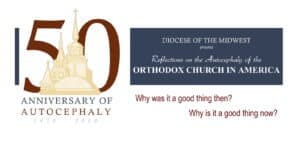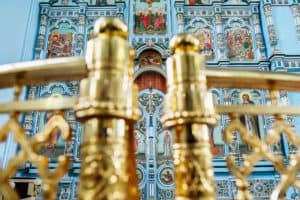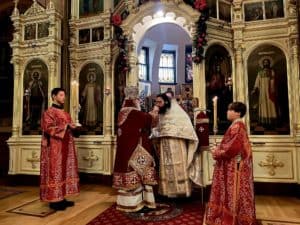PART IX
I was born in the mid-70s just a few years after the Russian Church granted the OCA autocephaly. At the time, my father was a priest in Orlando, FL at a small, newly formed mission. When I think about these early years of my life in Central Florida, my memories are wound together with church life. My perspective of the OCA and its new status as an autocephalous Church came from observing my father’s work and dedication. I remember my father’s enthusiasm and seriousness about his work. It is impossible for me to reflect on what autocephaly meant for the OCA and for our young mission in the 1970s without understanding who my father was and how he became the priest he was.
My father was born in Lebanon, PA and grew up Roman Catholic. As a boy he was involved in the local Catholic parish, attending church on Sundays and serving as an altar boy. Even from his Catholic school days, he was attracted to the Orthodox Church. Through some of his friends, he was exposed to the local Serbian Orthodox Church. The Orthodox Church’s expression of the ancient faith through its liturgy, music, architecture and icons attracted him. So, as a young adult, my father started attending the Byzantine Catholic Church. In my father’s words, he thought he could remain in the Catholic Church but worship as an Orthodox Christian.
In the mid-1960s my father enrolled in Sts. Cyril and Methodius Byzantine Catholic Seminary in Pittsburgh. Even though the seminary was technically part of the Roman Church, the administration decided to open its doors to Orthodox professors from St. Vladimir’s Seminary in NY. In my father’s fourth year Fr. John Meyendorff came and lectured on church history. Fr John was so well received that, soon after, they invited Fr. Alexander Schmemann to speak on liturgy for a week. These lectures, too, were very popular, but their effect was devastating to the seminary. In the days following them there was a mass exodus of students. My father says that more than half the seminarians left. Some simply left the seminary, while others left and converted to Orthodoxy. My father left, converted to Orthodoxy, and eventually enrolled at St. Vladimir’s.
In Fr. Alexander’s lectures, my father recognized something that was absent in the Byzantine Catholic Church. Byzantine liturgy, icons, and chant were not enough to express the ancient faith, and Fr. Alexander revealed these missing elements in his words and presence. Without a doubt, this was the most important moment in my father’s life. If he had not heard Fr. Alexander’s lectures, my father would not have become Orthodox, would not have met my mother, and would not have become an OCA priest. I can’t overstate this more. The degree to which Fr. Alexander Schmemann positively influenced people, shaped St. Vladimir’s Seminary and the minds and missionary zeal of its students was incalculable. His influence and vision of what an independent, autocephalous church in North America should look like, act like, and become reached deeply into his students.
Much has been written on Fr. Alexander’s vision of church and liturgy, and how these aspects might be enculturated and woven into North American society. However, I don’t think much has been written about how his work has influenced the life of his students, especially those who were inspired, ordained and sent out to parishes like soldiers going into battle to carry out an honorable mission. The battle was for truth – truth found in Christ and expressed in His Church through scripture and liturgy. It was also against secularism, clericalism, and legalism, all of which distorted this message of truth and, from the point of view of Fr. Alexander, led to an unhealthy and even corrupt form of church life. For this battle, the Church needed well-educated clergy who were capable of pastoring their flock. North America was the battle ground and it was here that an autocephalous Orthodox Church – founded on truth and led by its clergy – was ripe for germination and growth. North America was also a place with little history of Orthodoxy. Here was a chance to have a fresh start, and build an autocephalous church that kept the dogmatic and liturgical truths of the Church, and left secularism, clericalism and legalism behind. In the eyes of Fr. Alexander and his students the potential for establishing this indigenous Orthodox Church was limitless. The students saw this and believed it. These young priests were inspired. In a good way, they were zealous, full of hope, ready to sacrifice their lives and good salaries to disseminate the knowledge and vision they had received from their teacher. Their task, whether they understood it or not, was essentially to take the Metropolia (the OCA) out of its ethnic ghetto, strip it of its cultural underpinnings that might distort the gospel message, and make it accessible to a North American population. In short, this vision was the inspiration for the creation of an autocephalous church on this continent.
My father was one of these soldiers sent out into the field – sent out into the nether regions of the Metropolia – to a mission parish in Florida in the early 70s. From my father’s point of view, there was huge benefit in going to a mission parish so far from the epicenter of the OCA. It was an opportunity to establish good ecclesial and liturgical principles easily. He was doing the work of the Church, but just as importantly he was establishing practices that were both engaging to people and reflected ancient Christian liturgical principles: audibility, intelligibility, eucharistic participation, and liturgical movement. English was used exclusively and traditional “silent prayers” were read out loud. Communion was the central point of our Christian life and it was expected that everyone participated. The Church space should be open. Worshippers should be free to move about and unencumbered by pews for prostrations, kissing icons, lighting candles, going to communion; and so, no pews were introduced. All these principles formed the framework for a particular vision of the Church, a Church for North America, an independent, indigenous Church.
Maybe not unlike many other priest families, Church was very important to us. Autocephaly was not something we necessarily talked about, but as a family we were also on this mission with my father. Even though he wasn’t there, Fr. Schmemann’s words and ideas rang out into the parish community. You could hear his words about community, liturgy, and autocephaly seeping in through the walls of the church. As a young boy whose imagination was captured by church things, this had a profound effect on me. I understood that the Church was good, and that the OCA’s autocephaly was an important tool for Orthodoxy to become established in North America. I understood my father’s devotion to the Church, inspired by the words and vision of Fr. Alexander. For, the Church’s leadership had charisma and vision, and this translated into optimism and energy for my father, and for me.
If my experience as a young boy in Central Florida at St. Stephen’s is representative of the general environment of the OCA not only at that time, but just a short decade and a half earlier in the 60s, then it can be argued that autocephaly was not only an important goal for the Church in North America, but also good for it. Obviously, though, much time has passed since then. It’s been only 50 years, but many things have happened in North America since then that have affected the make-up, disposition, and self-identity of Orthodox Christians in North America. I think it is fair to say that people from my generation hold a certain ambivalence towards autocephaly that those of my father’s generation did not. My experience in the Church as a middle-aged clergyman is different than was my father’s. Mass immigration from Central and Eastern Europe, and from other places too, has been both a challenge and blessing for some parishes and dioceses. Inter-jurisdictional relations on this continent have not necessarily gotten any better over the past few decades. If an autocephalous Church is the main goal among all jurisdictions in North America, then it might be argued that relations between local Churches here have deteriorated since the 90s. Also, the OCA has gone through its own set of problems this past decade.
On a wider scale, too, there seemed to be many positive things building towards the vision of a united North American Church: SCOBA; three ethnic dioceses joined the OCA; good cooperation between OCA and the Antiochian Archdiocese and other Churches. In some ways, these tendencies and desires of working together and unity were a reaction to what was happening in the world at the time. Socialism and state-sponsored atheism divided the world and there was threat of nuclear war. Nazi Germany and WWII were not such a distant memory, and the Vietnam conflict was politically divisive. As sort of a counter balance to these tragic 20th century ideologies and events, the Ecumenical Movement brought together various faiths, including Orthodox from behind the Iron Curtain. Leading the charge of Orthodox participation from North America in the Ecumenical Movement were Frs. John and Alexander from St. Vladimir’s Seminary. The Orthodox Church in North America had a voice on the world stage, and this voice was through St. Vladimir’s Seminary and the work of its dean, Fr. Alexander.
All of these positive events and experiences in my youth led me to love the Orthodox Church. I truly believed (and still believe) that it’s in the liturgical life of the Church – through scripture, hymnography and the liturgical arts, corporate worship, and the eucharist – that we find Christ and salvation. Eventually, I attended St. Vladimir’s Seminary. I worked as a choir director in Chicago, got married, and was then attached as a deacon to St. Mary’s Cathedral in Minneapolis, fulfilling my diaconal duties as choir director, and then only recently was assigned as rector of St. Paul the Apostle Orthodox Church in Dayton, Ohio. Where I am now is quite a far cry from where it all started for me in Central Florida. Does autocephaly mean something different for me and for the Church now that I’m part of a completely different community and so much time has passed? I think fundamentally the idea of one Church for North America is good and, in theory, normalizes an otherwise uncanonical situation in North America. Fifty years ago, the Metropolia, with the vision of its leadership, clergy, and people, was ripe for autocephaly. But, it’s my experience that autocephaly means something different now for the OCA’s faithful and for me.
If fifty years ago the buzz word in the OCA was “autocephaly,” I think now it’s changed to “community.” A half century ago the word autocephaly was fresh and exciting. The OCA, soon after receiving its tomos from Moscow, elected an American born, English speaking metropolitan. We were forging ahead, exercising our independent status, and flexing our muscles, as it were, however small they may have been. But, as I started to say a moment ago, many things have happened since then that have shifted people’s focus, some of them circumstantial, and others just sinful administrative mismanagement at the OCA’s national level.
The OCA’s autocephaly has been significantly affected, in ways both positive and negative, by the disintegration of the Soviet Union and Soviet Bloc countries. Up until the beginning of the 1990s there was little to no emigration from these countries to North America. The last major immigration that affected the OCA was in the late 40s after WWII. By the 90s these people were already well assimilated and had children and possibly grandchildren who were American. The immigrants in the late 20th century forced many non-ethnic churches to scramble and find a way to minister to them. There are stories of OCA parishes successfully accommodating and integrating these immigrants into their community. In other instances, though, some parishes that were moving in the direction of using English and assimilation found it needful to reverse that direction. Also, immigration swelled the population of some already existing ethnic churches, possibly reinforcing the idea that Orthodoxy exists only within a particular culture, a non-North American culture. As a result, the focus of various ethnic Orthodox jurisdictions and parishes in the OCA shifted. The parish’s orientation was more internal than it was external. The result, I think, was that these parishes began to think less about Orthodox unity and more about their own dioceses and parishioners.
One of the more practical reasons the OCA received autocephaly from the Russian Church was because of the latter’s inability to function properly and to minister to its North American flock. In the Tomos of Autocephaly, there was a sense that an independent Metropolia would serve as a vehicle to unite the various jurisdictions into one “Autocephalous Orthodox Church in America.” This church would function as any other of the 14 autocephalous Churches, and the Russian Church would honor her presence as the Church in North America. Paragraph 10 of the tomos reads:
“The Moscow Patriarchate shall not receive into its care in North America any clerics without written release or any parishes except parishes from uncanonical ecclesiastical organizations in Canada; and shall not canonically permit clergy and parishes remaining in its care to enter any of the Orthodox jurisdictions but the jurisdiction of the Autocephalous Orthodox Church in America.”
One could argue that the Russian Church’s reunification with the Russian Orthodox Church Outside of Russia (ROCOR) violated this agreement. At best, it brings a non-canonical group back into a canonical church; at worst it undermines the OCA’s autocephaly.
Of course, there are other examples of autocephalous churches establishing parishes or bringing non-canonical groups under their omophorion in North America. This is not unusual. Some of these Churches support our autocephaly, while others are indifferent to it, or simply reject it. Whatever the case may be, when it comes to the OCA’s canonical territory, with only a few exceptions, almost all of the autocephalous Churches act as if the OCA is not autocephalous. If we, as the OCA, say that we’re autocephalous, then we should not only act that way, but be treated that way. I think all of this adds to the confusion of our self-identity as an autocephalous Church and its dubious status in the Orthodox world.
The difficulties that the OCA went through in the early part of the 21st century – the financial mismanagement at the national level, the lawsuits and defrockings that followed, and the three different metropolitans that we had within the span of a few years – all may have contributed to the indifference parishioners might feel towards our autocephaly. It is worth acknowledging the effects these crises have had on the OCA faithful. For one thing, these mismanagements encouraged parishes that otherwise would have not been insular to look more towards themselves and focus on their own community. How important is autocephaly in the face of financial mismanagement and scandal? How important is the vision of an indigenous, united Church in North America when the OCA can’t manage itself? What does it say about Orthodox unity when the very church leading the way exhibits disunity and dysfunction? These are real questions that presented real problems, not just legal and ecclesiastical, but spiritual as well.
Unfortunately, some faithful did leave the OCA because of this. The vision of the mid-to-late 20th century was lost. If autocephaly at one time was the OCA’s raison d’être, it obviously was not attractive enough to keep parishioners through these rough times. Ironically, the existence of multiple jurisdictions was a comfort for people dealing with this scandal. One could easily choose another church and not be reminded of these terrible things. Going to another Orthodox Church, whose patriarch lived in a foreign country, didn’t speak English well (or not at all), and was not from North America, was a spiritual necessity for some.
A few years have passed since the scandal, and the OCA has gone through a complete overhaul of its staff and clergy at the administrative level. These are positive steps towards restoring trust and reestablishing a healthy environment. Some may argue that making it through such a scandal is testimony to the OCA’s ability to function as an autocephalous Church. This might be true, but people are still wondering: is the OCA’s autocephaly relevant? Does it matter that there’s an Autocephalous Orthodox Church in America? I really don’t have a good answer to this. I’d like to think so, though. I’d like to think that the vision established by Fr. Schmemann and those at St. Vladimir’s is not lost. I’d like to think that the heart of this message still resonates, still inspires, and still motivates people to be Orthodox and to have our own local Church. Whether or not this is the case, the OCA is an autocephalous Church, and its clergy and people should live Christ’s Gospel in this land as best they can. At the very least, if this is the ultimate goal, and the OCA understands it in this way, then I believe the reasons for autocephaly fifty years ago are just as valid today as they were then.




